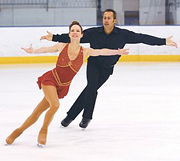Take to the Ice
By Editorial Staff
Ice skating tones the body, builds cardiovascular fitness and can burn almost as many calories as jogging. Find out how a healthy diet, physical fitness and chiropractic care have helped two professional figure skaters realize their dreams.
The U.S. Adult Figure Skating Championships is the most prestigious adult ice skating competition in the United States. First held in 1995 in Wilmington, Del., the event has occurred annually ever since, with an average of 500 competitors per year. Ice skaters from all over the U.S. gather to pursue dreams of gold medals, flawless programs and perfect 10s.
After years away from the sport, pair skaters William Abel, 40, and Choeleen Loundagin, 39, returned to the ice, winning gold at the 2007 adult championships. Their program won top marks with music from the Cutthroat Island soundtrack and a series of intricate leaps and throws, including an overhead press lift with one arm, split double twist, throw double toe and throw double Salchow.
Even for accomplished skaters, making time during an intense training schedule and staying in shape for the challenge of competition can be difficult when maintaining jobs and a life outside of skating. Despite their hectic schedules, Choeleen works as a sports psychology consultant and William is a landscape designer in Sonoma County, Calif. In this exclusive interview, William and Choeleen explain why with proper nutrition, exercise and chiropractic care - young or old, amateur or professional - it's never too late to skate.
How do you prepare psychologically for competition?
 Choeleen: I have a master's degree in sport psychology, I teach a sport psychology class, I wrote The Inner Champion: A Mental Toughness Training Manual for Figure Skaters, and I co-produced a performance enhancement CD, "Skate for the Love." In addition, I coach competitive figure skaters and I work as an athletic performance enhancement consultant. One of my primary motivations for returning to competition after a 22-year hiatus was to challenge myself to practice what I preach. I wanted to prove to myself that the skills I teach athletes would in fact allow me to perform my best while also enjoying the experience. I am happy to say that I was able to do just that by using imagery to prepare for the experience, affirmations to keep my confidence up and my perspective in check, controlled breathing to remain relaxed yet excited, and goals to keep my focus on what I can control (which was having fun while focusing on doing one element at a time to the best of my ability). The mind-body connection is an amazing thing.
Choeleen: I have a master's degree in sport psychology, I teach a sport psychology class, I wrote The Inner Champion: A Mental Toughness Training Manual for Figure Skaters, and I co-produced a performance enhancement CD, "Skate for the Love." In addition, I coach competitive figure skaters and I work as an athletic performance enhancement consultant. One of my primary motivations for returning to competition after a 22-year hiatus was to challenge myself to practice what I preach. I wanted to prove to myself that the skills I teach athletes would in fact allow me to perform my best while also enjoying the experience. I am happy to say that I was able to do just that by using imagery to prepare for the experience, affirmations to keep my confidence up and my perspective in check, controlled breathing to remain relaxed yet excited, and goals to keep my focus on what I can control (which was having fun while focusing on doing one element at a time to the best of my ability). The mind-body connection is an amazing thing.
Can you describe your training regimen? Has it changed over the years?
William: My training regimen as an adult is much more focused and goal-oriented than it was when I was younger. I don't have the same amount of time to devote to training as I did 20 years ago. Spending four hours on the ice every day, plus many more hours of off-ice training isn't realistic anymore. I only have an hour on the ice with my partner five days a week, so we really have to use that hour wisely or else we won't be able to do everything we need to do on a daily basis. Every day, I have a mental game plan for our practice session.

